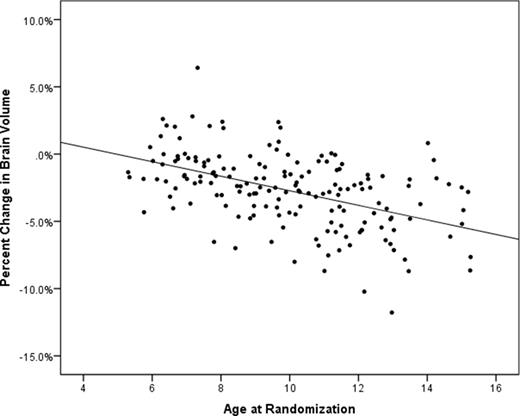Abstract
Introduction: Neurological injury is a common complication of sickle cell anemia (SCA). SCA is the most common cause of stroke in children between 1-14 years of age, while silent cerebral infarct is the most common neurologic injury in this population. Young children are particularly vulnerable to the adverse impact of strokes, and are at risk of cognitive and developmental deficits; thus, we sought to examine brain volume changes in children with SCA.
The Silent Cerebral Infarct Transfusion (SIT) Trial was a multicenter trial designed to determine the efficacy of blood transfusion therapy for prevention of recurrent silent cerebral infarcts in participants with SCA. This intervention trial followed 196 children with SCA aged 5-14 years randomized to receive blood transfusion therapy or observation for 36 months (DeBaun et al. N Engl J Med. 2014;371(8):699-710). As a planned secondary analysis, we used the SIT Trial brain imaging archive to determine longitudinal brain volume change in children with SCA. We performed a multivariable analysis using demographic and clinical variables to identify predictors of brain volume change.
Methods
SIT participants: The current study used a subset of the registered participants (n=169) in the SIT Trial with brain MRIs at study entry and exit, demographic and clinical information.
Estimation of brain volume and percent brain volume change: Baseline brain volume and longitudinal percent brain volume change (PBVC) were derived from T1-weighted structural MRIs using the automated image analysis programs SIENAX and SIENA, respectively, from the FMRIB Software Library (FSL) (www.fmrib.ox.ac.uk/fsl). For each participant, PBVC was calculated between entry and exit brain MR scans, a mean time of 41 ± 6 months. A negative PBVC indicates a decrease in brain volume and a positive PBVC indicates an increase in brain volume. All analyses were performed blinded to the participant's identity.
Statistical Analysis: A multivariable linear regression analysis was used to determine predictors of PBVC. The model included the following potential covariates : demographic variables (age, gender), laboratory measures (baseline oxygen saturation, steady state hemoglobin, steady state WBC, systolic blood pressure, % Hemoglobin F, steady state reticulocytes), clinical measures (acute chest syndrome and painful crisis rates), and regular transfusions provided as part of the trial.
Results: Of the 169 SIT participants, 96 were male and 73 were female, including 80 participants in the observation group and 89 in the transfusion group. Median normalized brain volume was 1,237.6 cm3 at the study entry and 1,194.7 cm3 at exit. Baseline brain volume in males was different from females (1,290.6 cm3 vs. 1,166.6 cm3; p<0.001). Comparing total brain volumes from entry to exit, the mean percent brain volume change was -2.7% (median, -2.4%; SD, 2.75). Percent brain volume change in males was not different from females (-2.6% vs. -2.8%; p=0.75). In the multivariable analysis of demographic, clinical, and pain measures, age was the only significant predictor of PBVC (p<0.001) (Figure 1).
Conclusion: Using longitudinal MRI images from the SIT Trial, we demonstrate progressive brain volume loss in children, with SCA with a mean percent brain volume change of -2.7% in the SIT Trial cohort. In comparison, brain volumes of children without SCA have been reported to remain stable in this age group (Cereb Cortex. 2012; 22 (1):1-12). We conclude that loss of brain volume begins early in children with SCA. Further investigations into the etiology of brain volume loss in children with SCA, and measures to better understand and reduce or prevent brain volume loss in SCA are needed.
References
1. Controlled trial of transfusions for silent cerebral infarcts in sickle cell anemia. DeBaun MR, Gordon M, McKinstry RC, et al. N Engl J Med. 2014;371(8):699-710.
2. Total and regional brain volumes in a population-based normative sample from 4 to 18 years: the NIH MRI Study of Normal Brain Development. Cereb Cortex. 2012;22(1):1-12.
Age at randomization versus percent change in brain volume in 169 participants randomly allocated to receive blood transfusion therapy or observation for median of 36 months.
Age at randomization versus percent change in brain volume in 169 participants randomly allocated to receive blood transfusion therapy or observation for median of 36 months.
No relevant conflicts of interest to declare.
Author notes
Asterisk with author names denotes non-ASH members.


This feature is available to Subscribers Only
Sign In or Create an Account Close Modal